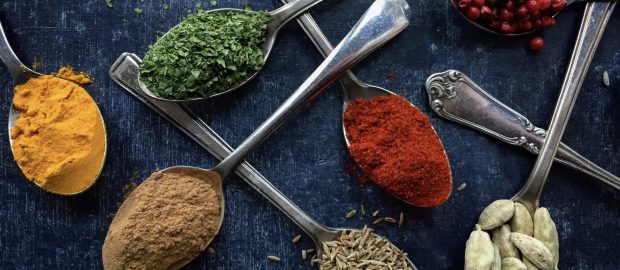King of the Curries: Back to Basic
Curry cooking techniques explained by the experts…

Bath-based cookery teacher Bini Ludlow has been cooking authentic Indian cuisine since a young age, having learnt her skills and knowledge about spices from her mother and extended family, many of whom still live in the Gujarat region of Western India. Who better for FOODLOVER to quiz about the basics of cooking curry and the stunning spices of India…
“One of the first things people ask when they come to a cookery session at Sweet Cumin is always about the spices. How to use them? What are the best blends? How long do they keep?
I was given a masala daba (spice tin) by my mum when I was married as a gift and it is my key piece of kitchen equipment that I use every day. It’s like my best friend. My spice tin contains coriander powder, cumin powder, garam masala, turmeric powder, chilli powder, cassia bark, mustard seeds, cardamom pods and cloves. I see these as the essentials to basic Indian cookery. They all have very different uses and flavour notes. I also enjoy working with dried whole chillies, which are great for adding flavour to oil.
Whole spices add a strength of flavour to curry; they are powerful, brilliant and start the whole process. They add flavour to the oil, but only when heated. Just avoid burning to prevent a bitter taste which can ruin your ingredients. Whole spices have a longer shelf life of 12 months and it is recommended you store them in an air-tight container.
Ground spices are used to add the next level of flavour to the curry. This part of the cooking journey should begin after you have added onions or ginger, garlic or chilli paste to the curry base. They will not burn as the other ingredients will absorb the ground powders. These tend to have a shorter shelf life of 3–6 months.
A top tip for checking whether the spices are fresh is to taste them. If they taste good, as they should, then they are worth keeping. If they don’t have any flavour, it is time to throw them away and replace with a fresh batch.
Many recipes may ask you to toast your spices. These should always be the whole spices and heated in a frying pan on a gentle heat. The oils from the spices are released when they turn light brown, and at this point it is best to remove them and put them straight into a mortar and pestle. The nutty aroma and colour change is inviting, and the harshness of the spices is removed by this process.”
Bini’s quick-fire curry quiz
- What is the best starting point for any simple curry? Buy the best quality fresh ingredients, including onion, ginger, garlic, chillies and fresh coriander to name but a few. A curry has many complex stages in its preparation and cooking, and every ingredient must reflect this; from the oil used, spices, the main ingredient as well as what it is accompanied with.
- What is your top spice blend for a tomato-based curry?Coriander, cumin, turmeric and chilli powders, Bini homemade garam masala (secret recipe) and lots of love.
- What is yourfavouriteIndian-inspired side dish to curry? This is difficult, I love dhal with rice. I also like a good vegetable curry. My favourite would be Gujarati ‘sambaro’. It is a carrot, pepper and cabbage salad that is served warm, spiced, and has a sweet and sour flavour with a little chilli kick. It is colourful, crunchy and light.
- Fresh, powdered or flaked chilli for the most aromatic, warm chilli flavour? All of them. They are used in various curries for different uses. Dried chillies are perfect for tempering the oil, fresh chilli can give depth and heat, and powered can give a kick and sweetness to a curry.
- What is your top tip for fluffy, perfectly cooked rice?The rice must be cleaned and washed carefully as well as also being allowed to soak.
For more from Bini and her curry cookery courses, visit; www.sweetcumin.co.uk
Article published by Food Lover magazine http://www.foodlovermagazine.com/
